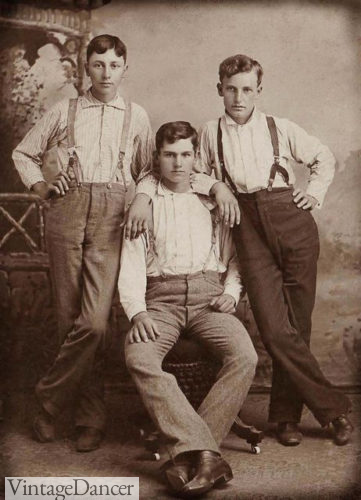However towards the end of the period the less restrictive Aesthetic style began to emerge. The single or double breasted frock coat fitted quite closely to the torso and had a waist seam.

Working Class Dress Lovetoknow
Women used boots instead of shoes.

. The need for a corset could well have been supplanted by alternative styles of dress which did not require a corset although. Middle-working class semi-skilled workers included carpenters bricklayers pipe fitters and factory employees. In eighteenth-and early nineteenth-century Britain the red woolen hooded cloak was commonly worn by rural women.
The railways generated employment for porters and cab-drivers. The fashion of the 19th century is renowned for its corsets bonnets top hats bustles and petticoats. Working class fashion - Late 19th century Ireland.
In the late 19th century about 80 of the population of the population was working class. Women and work in the 19th century. Most working class women in Victorian England had no choice but to work in order to help support their families.
The skirts were straight and finished to the mid thigh or below. Ad Browse Discover Thousands of Arts Photography Book Titles for Less. They could wear different garments for more rigorous activities and whether those were appropriate activities for ladies they were always appropriate for the working class and enslaved was a source of debate in the 1800s.
Women and work in the 19th century. Trousers became increasingly fashionable in the first quarter of the 19th century. In the 19th century a proliferation of womens magazine began to gain influence including Godeys Ladys Book 830 - 1898 Townsends Monthly Magazine 1823 - 1888 and La Follet 1829 - 1892.
Women and work in the 19th century. This was the top of the working class pyramid. See more ideas about 18th century 18 century art 18th century clothing.
The fashion of the 19th century is renowned for its corsets bonnets top hats bustles and petticoats. They could wear different garments for more rigorous activities and whether those were appropriate activities for ladies they were always appropriate for the working class and enslaved was a source of debate in the 1800s. They worked either in factories or in domestic service for richer households or in family businesses.
She researches and writes on all aspects of nineteenth century historyfrom animals art and etiquette to fashion beauty feminism and law. In the early 19th century some dandies wore boned corsets to give them a small waist. At first they were only worn for day and informal dress but by the 1820s they were acceptable for evening wear.
Waistcoats were always worn over a white shirt. These women did not have to do manual labor. Posted by 1 year ago.
Today the working class is not looked on by society as something to aspire to be but the whole class did not exist largely before the 19th century and was instead a peasant class existed that performed labor for lords of the land. Log in or sign up to leave a comment. Summer versions appeared in linen heavy cotton or seersucker.
Research into trousers will also consider issues of materiality as well as uncovering how quickly this new fashion spread amongst the working class. A skilled London coach-maker could earn up to five guineas 5 five shillings a week considerably more than most middle class clerks. While clothing was determined by the days activities the basic underclothes or foundational layer for all outfits a chemise drawers stockings corset and petticoats remained fairly consistent.
Corsetry in the 19th century was not only fashionable but seemingly a trend women were expected to follow there were implications of lax morals if a woman chose not to wear a corset. Rural women often made their own hats and. In the 19 th-century all women wore several layers of clothing though the clothing got more complicated depending on their socioeconomic status.
Male servants were much more expensive because men were paid much higher wages. In order to be considered middle class you had to have at least one servant. Pattens and then clogs were valuable assets for workingmen and -women on dirt roads and later in factories and mills.
Throughout the century service was a major employer of women. August 4 2017. Most servants were female.
Feb 18 2022 - Explore Charles Winchesters board Working Class Dress of the Eighteenth Century on Pinterest. Log In Sign Up. No belts were worn.
Working men wore vests of heavy cotton or denim. For day wear frock coats and straight trousers a short waistcoat and a shirt with a high stiff collar were worn. By the turn of the 19th century breeches pantaloons and trousers worn by all men were sewn with a flap in front called a fall front.
Florence Montgomery Textiles in America 1650-1870 London 2007 Vivian Richmond Clothing the Poor in Nineteenth-Century England New York 2013. The fashion of the 19th century is renowned for its corsets bonnets top hats bustles and petticoats. Working class fashion - Late 19th century Ireland.
At the eve of Industrial change throughout Europe London stood above the other powers. Mimi Matthews is the USA Today bestselling author of The Matrimonial Advertisement The Pug Who Bit Napoleon and A Victorian Ladys Guide to Fashion and Beauty. Gradually men adopted long trousers rather than knee breeches.
Womens fashion during the Victorian period was largely dominated by full skirts which gradually moved to the back of the silhouette. Op 1 yr. Even laborers wore vests at work as appearing in only a shirt was considered inappropriate.
19th Century Urban Working Class. The Working Class This was the upper lower class in the hierarchy. Upper class men wore silk or wool broadcloth vests.
Fashionable dress as seen in our images was only available to the wealthy. This flap was universally held in place by two or three buttons at the top. The London omnibuses needed 16000 drivers and conductors by 1861.

Working Class Victorian Life Witness2fashion

A Working Class Family Circa 1880 Victorian Life Class Outfit Victorian Clothing

1910s Men S Working Class Clothing
Everyday Clothes This Victorian Life

Overalls For Women Victorian Fashion Edwardian Fashion Fashion

Stitching The Fashions Of The 19th Century Who Dressed The 19th Century Elite

1840 1849 Fashion History Timeline

Working Class Fashion Late 19th Century Ireland R Historicalcostuming
0 comments
Post a Comment